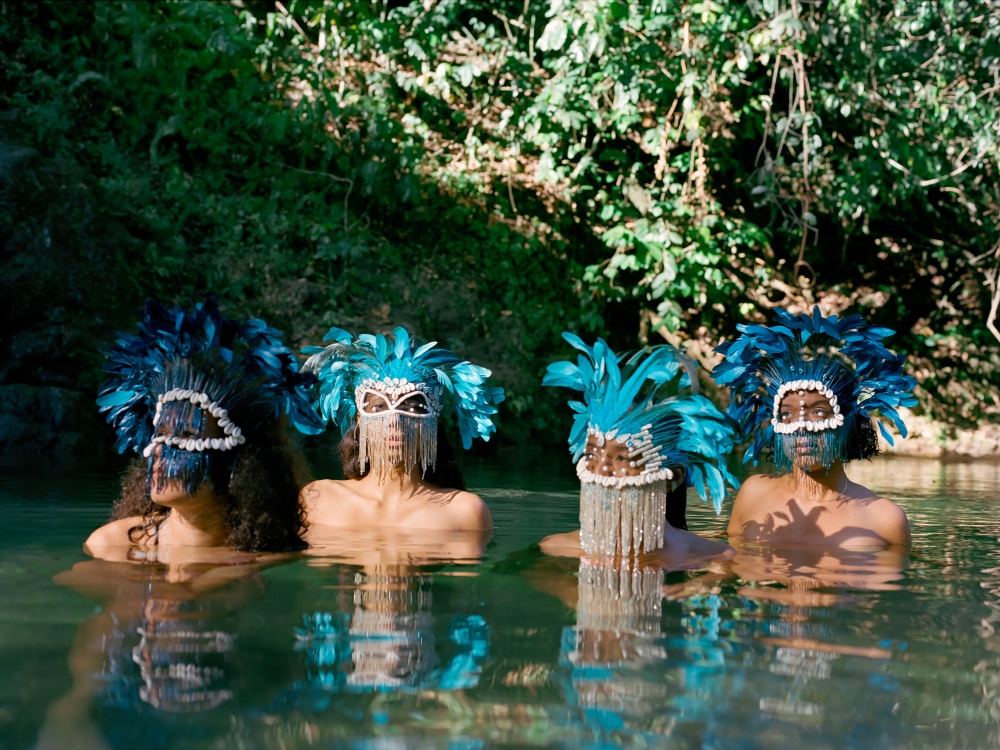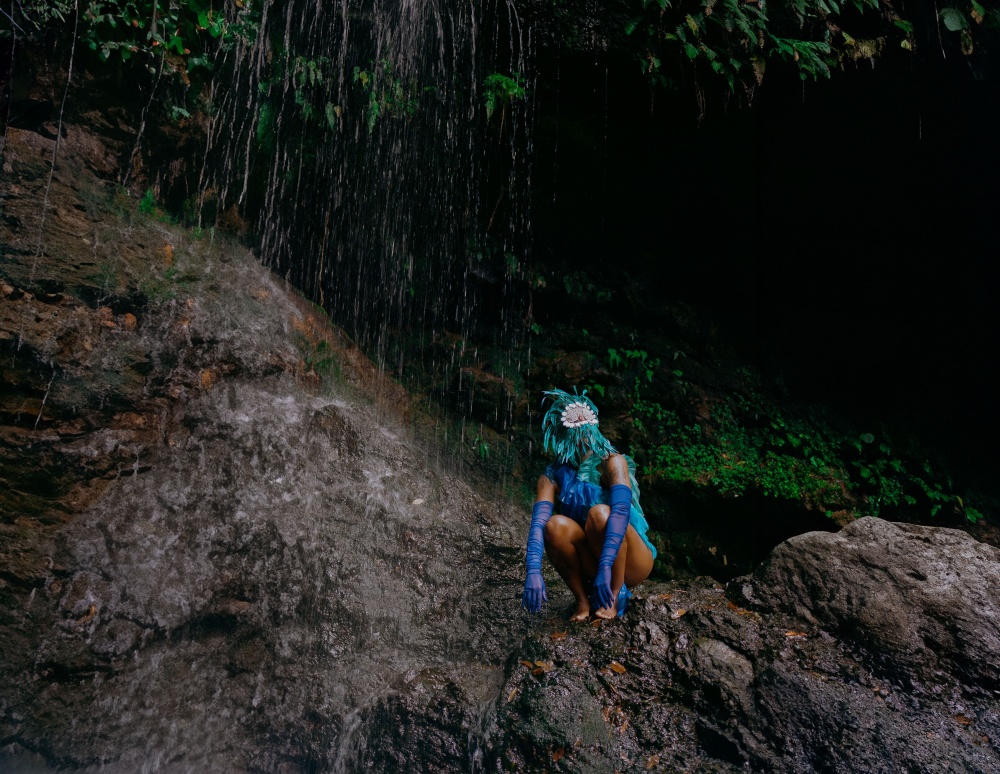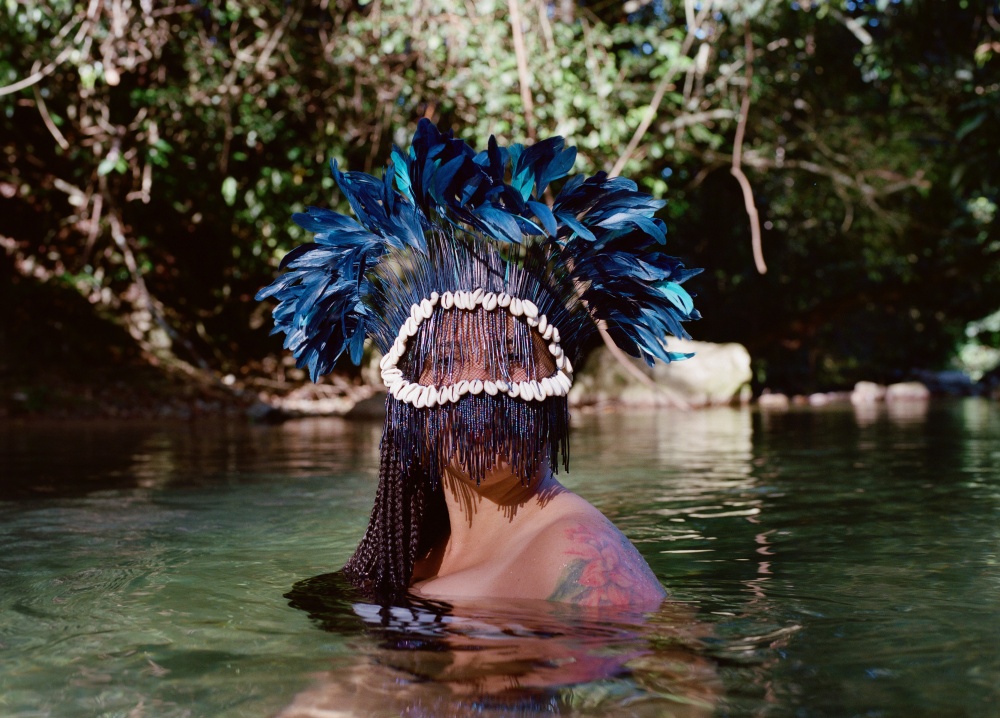Editor’s Note:
Contemporary Projects features original projects driven by artists, designers, or curators, highlighting diverse, critical forms of knowledge directly produced by art and design practices.
As part of our editorial work to place contemporary art practice in conversation with our archives, we’ve paired Yelaine Rodriguez’s newly published essay, “Children Of The Water,” in which the artist shares how her photographic series materializes from her own migration histories and relationship with water, in conversation with Emma Chubb’s essay from the AJO archives, discussing contemporary artworks that address trans-Mediterranean crossings: Small Boats, Slave Ship; or, Isaac Julien and the Beauty of Implied Catastrophe, which originally appeared on May 5, 2016.

Blindaron mi pecho, con un fuerte abrazo azul cobalto y larimar.
Cruzaron la puerta, destruyeron la llave, destrozaron con machetes la pared completa y me mostraron el mar. “Ese océano también es tuyo, dijeron, no te dejes engañar.”
They shielded my chest with a firm embrace of cobalt blue and larimar.
They crossed the door, destroyed the key, shattered the entire wall with cutlasses, and unveiled the sea. “That ocean is also yours; they said, don’t let them deceive you.”
—Azabache by Yaissa Jiménez, 2022
At thirteen years old, while on la tierra natal de mi madre in the Dominican Republic, my cousins and I decided to remain on the beach despite the sudden tropical storm that hovered over our heads, frightening my mother to death. We only returned to shore when the waves became too violent to endure. My mother’s trembling hands and frantic eyes cut straight through our collective laughter. Although I felt remorseful for generating anguish in my mother, I was unfazed, oblivious to the dangers the ocean—which brought me tremendous pleasure—also harbored. As a child, my inability to swim was never an issue, as I immersed my whole being in Mami Wata’s embrace. I was a city kid, born and raised in the concrete jungle of the South Bronx. Our nearest body of water was Orchard Beach, an artificial shore incorporating landfill and barge-loads of sand and the Bronx’s sole public beach. I yearned for summer trips to the island to feel genuine crystal turquoise water. I often accompanied my mother to the island; we visited my father every summer. At the time, I was unaware of water’s geopolitical usages and the unnatural boundaries between nation-states that kept us apart ten months out of the year; I was simply delighted to see my island and relish in its warm embrace.
In 2014, three months into backpacking around Mexico, I entered uncharted waters away from my mother’s protective gaze. I made one misstep, and the vexed water blanketed me. Each time I penetrated the surface and gasped for air, I visualized my mother’s face in despair at the thought of my being swallowed whole. I was a twenty-three-year-old carefree spirit roaming the world who had developed a random communication pattern, reporting home every other day. After the incident, I immediately secured a one-way ticket back to the Bronx. Surrounded by strangers and utterly alone, I contacted my sister from a pay phone in Mexico City and announced, “Hey, I almost drowned, but I am ok; I am heading back home tomorrow. Don’t tell mom.” I only informed my mother about the incident once I was safely back at her kitchen table in the South Bronx.
My present relationship with Mami Wata is significantly distinct from my younger self during those early yearly pilgrimages to the island. I never learned how to swim. It took me a whole year before I touched another body of water. It might have been because I was in the Bronx all that time, away from the natural shores I adored, or I wasn’t willing to face Mami Wata’s grasp. In the Caribbean and the African diaspora, various female spirits are associated with water, including Yemaya, the orisha of sea waters, motherhood, and fertility, or Oshun, the orisha of sweet waters and sensuality. Throughout the Caribbean and Afro-syncretic religions, we tend to make the relationship between women and water “while men embrace ‘fire-like’ qualities like transformative, even destructive, power”1 like the orisha of thunder and lightning, Shango. Nevertheless, we neglect that the ocean’s waters can be equally destructive. As the National Geographic Society recently noted, “More than 80 percent of the ocean has never been mapped, explored, or even seen by humans.”2 Sometimes the unknown is further ominous.

Children Of The Water materializes from these lived experiences. It is an ongoing photo series that draws upon Afro-syncretic religions and histories of slavery and colonialism. The sitters are presented in or near bodies of water, adorned with masks that are hand embellished with elements of ofrendas, such as cowrie shells and indigo-dyed rooster feathers. I carry these blue masks during my travels, inviting locals to pose with them as we reflect and disseminate stories around water. Before I took the image in Bonao, Dominican Republic, in 2022, these four masks remained in my backpack for days until the perfect moment presented itself. These quick snapshots enable me to connect with the African diaspora at large, whether it be in the fresh waters of Bonao in the Dominican Republic, the predominantly Black aldea of Loiza, Puerto Rico, the border town between Morocco and Spain, the Afro-Mexican community in Oaxaca, Mexico, or the pulsing epicenter of Afro-Brazilian culture in Salvador Bahia.

Unlike my other photographic works, each detail of which I carefully plan prior to the shoot, Children Of The Water is free-flowing. I could carry these masks throughout my entire trip and never use them, or sometimes the stars align, and magic happens organically. Children Of The Water (Brazil) was one of those moments when you meet the right people at the right time. It was my first time in Brazil, I was there for a conference; for the most part, the opportunities to explore were limited. However, one night at an after-party, I was introduced to two beautiful souls. My friend knew I was looking for people to photograph and asked them if they would be inclined to pose for me. I was surprised by how open they were to the idea, especially when I told them I only had a tight time frame between 6–10 a.m. before I had to return to the conference. That was the quickest shoot I ever did. I was exhausted from working on the masks the night before. After three hours of sleep, I met them on the other side of town at Cachoeira de Oxum in Parque São Bartolomeu at their suggestion.

Even during tranquil periods, the water reminds us of the harrowing realities behind its geopolitical usages. Water is an element that holds our bodies and our memories, a medium exploited during the transatlantic slave trade that forcefully uprooted and transported enslaved Africans. In our present day, these waters transform into waterways and borders that divide the archipelagic and separate migrant families like mine. When filmmaker Jamal Ademola invited me to participate as a costume designer for his film Ellas Vinieron De Las Nubes, I was thrilled to connect with the Afro-Mexican community in Oaxaca. I was reminded how the waters that divide also connect us and how wonderful it is to have these moments of connectivity within the African diaspora. From that project, I was able to include the Afro-Mexican community in Children Of The Water, expanding the conversation and our collective understanding of Blackness.

Conjuring the Martinican philosopher Édouard Glissant, the mask element also calls for a “right to opacity that is not enclosure within an impenetrable autarchy but subsistence within an irreducible singularity.”3 For example, this doesn’t indicate the creation of an impenetrable wall that isolates us from others but the acceptance of the unique differences we individually carry within. In the case of Children Of The Water, the masks are boundaries that guard the subject’s spirit and energy when the reproduction of these photographs inevitably circulates via social media, museums, and publications, similar to the ones Brazilian Candomblé practitioners sport during sacred ceremonies. However the intention of these masks are unlike the definition of metaphorical masks that Ayodeji Ogunnaike uses “to explain how enslaved Africans and their descendants employed a facade of Catholic piety and identity as a strategy of resistance to keep the traditions of their African deities alive.” Instead, these masks serve as “methods of communication and concealment, techniques of community-building as well as self-individuation.”4 By concealing the subject’s faces, these hand-embellished masks form a homogenous Black diaspora, which allows room for others to reflect.
During the Middle Passage, a significant number of enslaved Africans took matters into their own hands, hoping that “death would take them back home to Africa,” taking a leap of faith into the deep ends of the waters. As their bodies made contact, the ripples rang throughout its surface. In these photographs, the camera captures the reflections in the waves echoing Christina Sharpe’s work, In the Wake: On Blackness and Being regarding Black mourning and the aftermath of slavery. To this day, marginalized Black bodies take a chance, crossing waters, desperate to reach the shores of nations they associate with more profitable futures. As Marisel C. Morena recounts, “I remember constantly seeing newspaper headlines about Dominicans and Haitians either dying or being captured by the US Coast Guard while trying to make it to Puerto Rico in yolas.”5 Our lives are inundated with images of migrants crossing borders, globally. Regardless of these imaginary “lines traced on maps to demarcate divisions between groups, nations, and countries,”6 numerous migrants still endure these treacherous journeys.
My interest is fostering circulations of Black resistance and memory that the colonial archives continue to erase but are embedded within the African diaspora living archives. Through art, I illustrate hidden narratives, providing a visual that can reach more diverse spaces and audiences than the original archival material. Employing Glissant’s parallel consciousness of self and surroundings as a means to reshape our understanding of Blackness and how it translates throughout the African diaspora via Afro-spirituality, provides a framework to examine Afro-diasporic communities not as separate commodities but as fragments that operate as a collective. Together, these photographs are formulating a new type of archive that provides alternative perspectives not usually occupied within the colonial archives. Although taken at different times and places, they are part of the same family and spirit, much like an archipelagic.
Yelaine Rodriguez is a Bronx-born interdisciplinary artist, curator, and scholar specializing in Afro-syncretic religions, free from stereotypes and the colonial gaze. She received a BFA from Parsons School of Design|The New School and an MA from New York University. Rodriguez has exhibited in Estamos Bien: LA TRIENAL 20/21, UNTITLED, and Photoville, and at the Mexic-Arte Museum (Austin), American Museum of Natural History (New York), Wave Hill (New York), El Centro Cultural de España and Centro León Biennial XXVII (Dominican Republic), SurGallery & Critical Distance Centre for Curators (Toronto), Wereldmuseum (Rotterdam), and Santa Monica and La Escocesa (Barcelona). Rodriguez’s works have been featured on CNN, Artsy, EnFoco, Hyperallergic, and in Vogue, Aperture, and Elle. Her writing has appeared in ARTnews and academic journals such as Latin American & Latinx Visual Culture.
- Vicky Mogollón Montagne, “Women and Water: Connections in Caribbean Music and Spirituality,” Smithsonian Folklife Festival, February 2, 2024. ↩
- Tyson Brown, “Ocean,” National Geographic Society, October 19, 2023. ↩
- Édouard Glissant, Poetics of Relation (Ann Arbor: University of Michigan Press, 1997), 190. ↩
- Kyrah Malika Daniels, “She Wears the Mask: Black Atlantic Masquerade in the Work of Carrie Mae Weems,” Carrie Mae Weems: Strategies of Engagement (Boston: McMullen Museum of Art, 2018), 49. ↩
- Moreno, Marisel C. Crossing Waters : Undocumented Migration in Hispanophone Caribbean and Latinx Literature and Art (Austin: University of Texas Press, 2022), 1. ↩
- Gloria Anzaldúa, Borderlands/La Frontera: The New Mestiza (San Francisco: Spinsters/Aunt Lute, 1987). ↩

